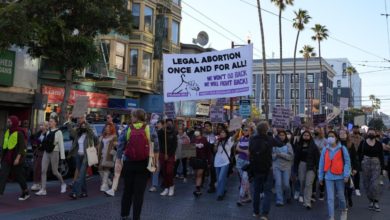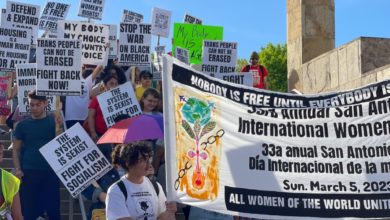Buoyed by a rising tide of civil rights victories and people’s struggles, from Black Liberation to the anti-Vietnam War movement, the so-called Second Wave of feminism erupted at the end of the 1960s and the early 1970s.
Women loudly took to the streets, with mass marches and bold disruptions of sexist business as usual. Women gathered in “consciousness raising” groups where they discussed their experiences of daily life. In such groups, “The personal is political” became a key phrase as women realized that sexism was expressed in everything from unequal pay, to the assumption that a woman office worker would make coffee, to the expectation that women would be the primary person caring for children in the family.
Through this process of consciousness-raising, women began to identify the issues that affected their lives. Women in every corner of society seemed empowered, stepping forward to demand their rights.
The mainstream media and capitalist politicians were eager to paint feminists as “man-haters” intent on overthrowing the “natural” order of the sexes. They misrepresented the feminists’ scathing indictment of sexism by portraying women activists as emotional and irrational.
A ‘cultural revolution’
In this era, women’s caucuses and organization sprouted up from within labor, civil rights, religious and student organizations. Male chauvinism, sexist gender stereotyping and the exclusion of women from leadership became the hot button issues in a veritable “cultural revolution” from within existing organizations around the country.
Within the male-dominated labor unions, militant women formed and successfully demanded recognition from the conservative male leadership of the labor federation for the Coalition of Labor Union Women. African American, Latino, Asian and white women united in this women’s led group from within the AFL-CIO.
Women, even those in progressive groups, were labeled as “divisive” or even “helping the enemy” by challenging the sexist routines. Men were supposed to do the talking and the women were supposed to do the administrative work. But these arguments were blown away by women who were unwilling to step back.
Sexist practices, which had gone unchallenged even within the left and progressive forces, were reflective of the culture and practices of capitalist society.
It was the determination and militancy of women, unleashed by the radicalism of the time, that shattered the old boys club mentality.
National organizations founded
Liberal and radical feminists founded the National Organization for Women in 1966. NOW had among its founders members of the Equal Employment Opportunity Commission who had been attempting to enforce the prohibition on sex discrimination mandated by Title VII of the Civil Rights Act of 1964. The focus of NOW and other liberal feminists has always been on winning reforms through legislation and the courts.
As the 1970s unfolded, Roe v. Wade represented a major victory for women’s right to control their bodies. The following year, the Hyde Amendment was passed, prohibiting the use of federal funds to pay for abortion—effectively making abortion inaccessible to women on Medicaid. While NOW and other liberal groups protested the Hyde Amendment, it was not a major focus of their organizing.
This lack of attention to the concerns of poor and working-class women, and women of color, became central to the critique of Second Wave liberal feminism.
Similarly, liberal feminism was slow to be inclusive of lesbians. NOW founder Betty Friedan instead sought to distance the organization from what she deemed the “lavender menace,” excluding pioneering lesbian group Daughters of Bilitis from the sponsors list for the first Congress to Unite Women in 1969.
Different trends within feminism
Socialist feminists, influenced by Marxism and revolutionary politics, played a key role in the women’s movement of the 1970s. Without a deeper historical framework, these socialists argued, it was easy to end up concluding that men were natural oppressors and sexism was thus inevitable. Instead, the Marxists insisted that women’s oppression is linked to the development of class society. Socialist revolution lays the basis for the eradication of sexism, and there is no permanent human nature at the heart of male supremacy that precludes equality and equal relations between the sexes.
The revolutionary socialist perspective differed from other trends within the feminist movement on this and other critical questions. Liberal feminists presented the women’s struggle as exclusively one of legal and formal rights within the capitalist system.
Other radical feminists insisted on patriarchy as a permanent cultural system, which could only be gradually addressed through education and better understanding. This view denied that women had a major stake in the revolutionary movements against capitalism and imperialism. More specifically, these trends tended to neglect the central importance of the Black liberation struggle and the special forms of oppression facing women of color.
The defeat of the Equal Rights Amendment
Liberal feminists tended to focus on lobbying, passing legislation and electing “pro-woman” (that is, Democratic) politicians to office. A major priority of NOW during the 1970s was the passage of the Equal Rights Amendment. Originally introduced in Congress by First Wave feminists in 1923, it passed both houses of Congress in 1972 and went to the state legislatures for ratification.
The amendment’s passage in Congress was a product of militant struggle by women, from NOW’s picketing and disrupting Congressional hearings to the massive Women’s Strike for Equality on August 26, 1970, marking the 50th anniversary of the passage of the 19th Amendment in which women won the right to vote.
After the ERA went to the states for ratification, and the decade wore on, it became clear that the amendment was in danger of not being ratified by enough states. NOW declared a “state of emergency” and went into a full-court press to secure its passage. Despite the overwhelming popularity of the ERA, it was clear that the right-wing opponents of the measure were determined to see it fail and would stop at nothing in the state legislatures.
Socialists, of course, fought for the constitutional recognition of the equality of women. Also, wiping out inequality in the legal status of women has been a critical first step in every socialist revolution.
Under capitalism, the passage of the ERA in and of itself would not have achieved the social or economic equality of women. It would have provided the legal foundation to advance the struggle against sex discrimination.
When NOW threw all its resources into the ratification of ERA, they shifted their energies away from the grassroots struggle to advance women’s social and economic status. The defeat of the amendment was seen as a defeat for the women’s movement as a whole, especially since NOW had staked its entire prestige on ratification.
The spirit of struggle
In the 1970s, women around the country entered the world of political struggle for the first time. They won important victories, dramatically shifted many people’s consciousness, and sparked critical debates about male supremacy in the people’s movements, and society at large.
One of the lessons of the 1970s for the women’s movement is that progress comes from mass struggle, and not from relying on politicians. Women need a social revolution, and thus must seek to build organizations and alliances with poor and working-class men and women, movements of the oppressed nationalities and the movement for LGBT equality, in a united struggle against capitalism.
A new women’s movement—linked to a new anti-capitalist movement—is emerging today in response to the attempts of the right-wing to reverse the gains of the past 40 years. That same in-your-face spirit of struggle that characterized the 1970s radical women’s movement will return with it. We will not be pushed back.






